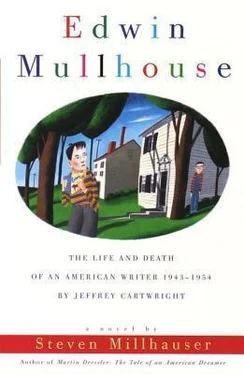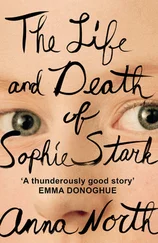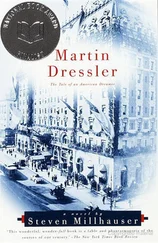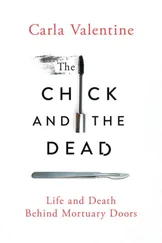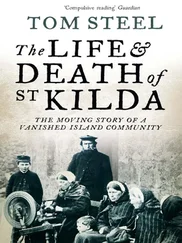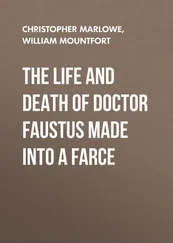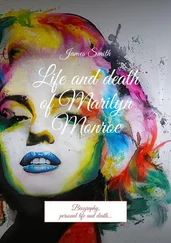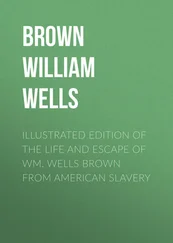Steven Millhauser - Edwin Mullhouse - The Life and Death of an American Writer 1943-1954
Здесь есть возможность читать онлайн «Steven Millhauser - Edwin Mullhouse - The Life and Death of an American Writer 1943-1954» весь текст электронной книги совершенно бесплатно (целиком полную версию без сокращений). В некоторых случаях можно слушать аудио, скачать через торрент в формате fb2 и присутствует краткое содержание. Год выпуска: 2011, ISBN: 2011, Издательство: Knopf Doubleday Publishing Group, Жанр: Современная проза, на английском языке. Описание произведения, (предисловие) а так же отзывы посетителей доступны на портале библиотеки ЛибКат.
- Название:Edwin Mullhouse: The Life and Death of an American Writer 1943-1954
- Автор:
- Издательство:Knopf Doubleday Publishing Group
- Жанр:
- Год:2011
- ISBN:9780307787385
- Рейтинг книги:3 / 5. Голосов: 1
-
Избранное:Добавить в избранное
- Отзывы:
-
Ваша оценка:
- 60
- 1
- 2
- 3
- 4
- 5
Edwin Mullhouse: The Life and Death of an American Writer 1943-1954: краткое содержание, описание и аннотация
Предлагаем к чтению аннотацию, описание, краткое содержание или предисловие (зависит от того, что написал сам автор книги «Edwin Mullhouse: The Life and Death of an American Writer 1943-1954»). Если вы не нашли необходимую информацию о книге — напишите в комментариях, мы постараемся отыскать её.
.
Edwin Mullhouse: The Life and Death of an American Writer 1943-1954 — читать онлайн бесплатно полную книгу (весь текст) целиком
Ниже представлен текст книги, разбитый по страницам. Система сохранения места последней прочитанной страницы, позволяет с удобством читать онлайн бесплатно книгу «Edwin Mullhouse: The Life and Death of an American Writer 1943-1954», без необходимости каждый раз заново искать на чём Вы остановились. Поставьте закладку, и сможете в любой момент перейти на страницу, на которой закончили чтение.
Интервал:
Закладка:
Oh they don’t wear pants
On the other side of France.
An incident which I here record as evidence of what I have so often noticed in my lifetime, namely, that even the most careful and scrupulous biographer cannot be too careful and scrupulous. I extricated myself with a casual “Oh, I don’t know,” and Mrs. Mullhouse returned to her book, and that would have been the end of it had not Dr. Mullhouse looked up and said: “We used to call it ‘They don’t wear pants on the other side of France.’ Salacious little thing, in my day.”
“Yes, well let’s not go into that, for heaven sakes. I’m sure Jeffrey has no interest in your salacious little days, dear.”
“So much the worse for him,” said Dr. Mullhouse, and returned to his book.
Mrs. Mullhouse was seated on the corner of the couch near the wall bookcase, with her tucked-up feet resting against the couch-arm, under a white sweater. As she read, her face was turned in the direction of her feet. Behind her, on the safe side of her head, the top of Edwin’s head slowly rose into view. Karen began to bubble with silent mirth as his forehead appeared, followed by his eyeglasses, his nose, his chin, his neck, and the white triangle of his t-shirt in its dark frame of shirt. As Edwin brought one elbow onto the top of the couch and slowly placed his chin in his hand, facing the head that was turned away from his gaze, Karen erupted into muffled laughter. Mrs. Mullhouse looked up with a smile and a frown, her eyes darting over her dress and legs. “Come on, you two, what’s the big” “Finished,” said Edwin softly, and Mrs. Mullhouse burst into a scream as a maddened bird flew round and round its cage, while Dr. Mullhouse, looking up over his bifocals, said sharply: “What’s all the racket? Where’d he come from? Finished what?”
12
FROM THE OPENING WORDS of Edwin’s immortal masterpiece we enter a precise and impossible world:
A white crescent moon, wearing a red nightcap that comes down to a long-lashed eye, snores in a blueblack-ink-colored sky above a twinkling town where the purple houses breathe in and out, in and out. One by one the yellow lights go out, each to a musical note. Down in the drowsy town the blear-eyed streetlamps yawn and nod, a corner mailbox snores through its mailslot, and shoulder to shoulder on the swaying telephone wires, the purple sparrows huddle in feathery sleep. Two black hiccupping cats come staggering along the road with their arms around one another’s shoulders, singing “Down by the Old Mill Stream,” while up above, the grumpy moon stirs in his sleep, and in the lamplit roadside grass a cricket wearing a tuxedo falls asleep under the eaves of a dark blue mushroom. Two glowing fireflies trace the words GOOD NIGHT against the dark. Now one by one the stars go out, each to a musical note. The world sleeps.
These familiar images, drawn from animated memories of technicolor cartoons, make up a world that I have called precise and impossible, and are the very heartblood of Edwin’s book. But the reader is mistaken who believes that Edwin shared with Edward Penn a desire for a free-floating cartoon universe bearing no relation whatsoever to anything in this world. For what shall such a reader think when on page 2 he finds himself before a tall moonlit door with cone-shaped bushes on both sides and the number 295 at the top? or when, entering the black front wall, and passing through the rattling inner door, he steps into a moonstriped living room and proceeds to climb the creaking stairs to a dark door, and entering comes to a slumbering form beneath a double window? That elaborate description of the snoring hero, whose every inhalation draws toward his crimson mouth a yellow-eyed black spider at the end of a violet thread, is most amusing. A sliver of moonbeam, shining diagonally through the edge of a window, “cuts the hero’s throat in half”—a bright foreboding. Slowly the moonbeam travels toward the hero’s eyes; and as it crosses the lids, they open suddenly, revealing, in anticipation of that final fourth-of-july burst of eye-images, two startled pink ostriches who stick their heads in the sand.
For despite Edwin’s repeated claim that his book bore no relation to his life, Cartoons is nothing less than a scrupulously distorted version of that life. It is a feature-length cartoon in technicolor, taking place during one timeless and enchanted night, bathed in cool midnight tones of silver, blue-violet, green-blue, and blue-green, with occasional splashes of lemon and crimson. Each episode is a dazzling cartoon painting, a scintillating series of unforgettable images that forms a precise and impossible picture. But this is not to say that the effect is static, for the images are always leading us somewhere, as if we were following a slow pan on the screen; and of course the three central adventures are bound by the familiar cartoon plot of elaborate pursuit. I shall now briefly summarize Cartoons, both for the sake of those unhappy readers who may not have read it (I assume, of course, that it will have been published by the time of this reading) and in order to provide fuel, so to speak, for the fiery remarks that follow.
The hero, waking in the moonbeam, and after a comic series of stumblings in his room and on the stairs, issues from his house, turns to the left, and walks along a glowing green-blue version of what is unmistakably Beech Street. He is followed by a mysterious black-cloaked figure in a broad-brimmed black hat, the lower part of whose face is concealed by the cape that he holds high with one arm “as if warding off a blow”; his bright yellow eyes are alone visible. Purple bats flutter in the vacant lots, a green-eyed black owl hoots from the rippling branch of a fat black tree, the purple shutters of a dark green house are blown suddenly shut by the wind; and when the hero climbs a little moonlit hill at the end of the street, while the black-cloaked figure watches crouching from a field, we are not surprised to see, standing before a purple-black stream on which green-blue shadows ripple, a tremulous and transparent ghost. The hero and the ghost step onto a raft and make their way downstream — followed by a distant raft — to the ghost’s home in a burrow or cave in the side of the steep bank (here Edwin seems to have combined Penn’s cellar with Rat’s home in The Wind in the Willows ). The delightful description of the ghost’s gloomy dwelling, in raw umber and blue-violet, is in my opinion one of the high points of the book. Who can forget the undulating fog-furniture, the clanking skeleton cat and the mouse of mist, the gloomy meal of moonbeam soup and cobweb stew served in hollow skulls by white-bibbed bat waiters, the skeleton-hand spoons and the lightning-flash knives, the row of black-framed family photographs each of which is blank, the coffin standing against the wall and containing on its shelves a dead letter, two deadlines, a dead heat, a deadlock, a deadpan, a death rattle, and a dead end, the fireplace where petrified wood is burned to produce the shadows of flames, the light-switch that causes an overhead cloud to drizzle, the bat-wing umbrellas, and the wonderful revelation that the melancholy ghost is an imaginative painter whose wildest fantasies resemble precisely the news photographs in the Sunday New York Times. After a curious game of chess, in which the pieces keep evaporating, the hero bids goodbye to the ghost and proceeds downstream on his raft, pursued by the mysterious figure in black, who emerges from behind some red-violet reeds. Rather abruptly the hero comes to a black forest on a hillside. He sees at the top, silhouetted against a big round yellow moon (Edwin forgets, or perhaps does not care, that his original moon was crescent and white), a crooked haunted house. The long climb to the house, in black and purple, in a traditional setting of green and yellow eyes, with the dark figure in slow pursuit, is a fitting prelude to the triumphant description of the stylized house itself: the bats fluttering from the windows, the tilted shutters, the owl on the gutter, the cob-webbed porch on which an empty rocking chair eerily rocks, the eyeless Raggedy Ann doll smiling in a corner, the sudden movement in a pile of old clothes as a green mouse scampers out, the front door hanging crookedly on a rusty hinge, the glowing green eyes behind the black windowpane, the creaking threshold, and then that evil front room: the piles of broken purple furniture striped by yellow moonbeams, the headless doll on the couch, the black furry spider on the coucharm, the green-eyed bat, the bearded grandfather clock who strikes thirteen, waking up a one-eyed black cat who has pieces of yellow straw and red wool in his jaws, the crumbling staircase with its tilted purple stairs and its lion-headed handrail that snaps at the hero’s hand as slowly he begins to climb, pushing away cobwebs and sticky moonbeams, climbing higher and higher until he comes to a tall purple door; and peeping through the keyhole he sees a weeping yellow-haired princess in a crimson dress seated on an emerald chair beside an ebony spinning wheel. The door swings open, revealing a black-eyed witch with thick black eyebrows and long black hair and a long black dress and long thin pointed black shoes. There follows a long nightmarish chase through all the rooms of the house (my favorite is the Cobweb Room with its sticky cobweb furniture, its sagging cobweb stairway, and its clinging cobweb cats), as smoke flows from under the door of the princess’s chamber and rolls down the tilted stairway in thick purple balls, until the house bursts into magnificent crimson and yellow flames that turn the midnight sky crimson and yellow, while frowning storm-clouds prepare for battle armed with bright yellow flashes of symmetrical zigzag lightning forged by a host of heavenly blacksmiths, and a gleaming giant smashes a vast gong. Angel-firemen dipping silver buckets into celestial streams pour down parallel slanting lines of violet rain. There is a beautiful description of calm after a storm, culminating in a midnight rainbow that casts rainbow shadows on the world below. The hero takes a last look at the charred ruin against the round and now scarlet moon and makes his way sadly through the dark trees, pursued by the figure in black, until he issues from the forest and finds himself standing at a far edge of town that he has never seen before. Slowly he wanders along the dark and crooked streets, silently pursued, until at last he sees a dim light in a cellar window, through which in vain he tries to peer. Nearby is a sloping and curiously realistic cellar door (such as Edwin had seen at the back of many a house on Benjamin Street). Lifting it, the hero descends a flight of dark stone steps and enters a large dim room filled with old suits of armor, rusty swords, Colt automatics, festoons of chains, piles of glossy black cannonballs, unnamed instruments composed of purple spikes and green toothed wheels, nooses of thick twisted rope dangling from dark ceiling beams, piles of pale crates labeled REMINGTON, steel traps that look like jaws — one of which snaps at the hero’s heels as he makes his way toward the distant light, which comes not from a bulb but from a flickering candle; and as the hero crawls past a final obstruction and creeps under a table, he sees before him a vast black wolf chained to the wall, straining at the end of its chain and dripping saliva that gathers in dark gleaming pools. And as the hero watches, he notices a white-haired lady in shiny black boots on a blue piano stool in the corner, who slowly rises and approaches the wolf, and raising a lash swings it onto the wolf’s back with a whistling snapping sound, drawing a great gash of crimson blood. Again and again she swings the lash, until the bloody wolf creeps to the wall; then the lady returns to her stool, where she falls asleep. There follows the hero’s unsuccessful attempt to free the wolf, the pursuit by the lady, the chase through the cellar, and the hero’s escape up the stone stairs and into the street, where for the first time he becomes aware of the figure in black. And now the book enters its final movement as the pursued hero hastens through a maze of misty streets — misty for no reason except that Edwin wanted mist — until he comes to the tall white door with cone-shaped bushes on both sides and the number 295 at the top. The concluding section of the book is a long chase through all the rooms of the hero’s cluttered house, in which we are briefly introduced to slumbering cartoon parents and a slumbering cartoon sister, and in which all the formulas of the cartoon chase are used in a kind of crescendo of clichés as the clumsy pursuer is continually outwitted by the clever pursued (the double-barreled shotgun is twisted into a pretzel, the sledge hammer strikes the pursuer’s toe and sends a gong into his eyes, the pitchfork-pierced belly turns into a sprinkler when water is swallowed), and just as we have become accustomed to these rather brutal conventions, and the smiling hero crawls complacently into bed beneath the same old spider, suddenly there is an unexpected reversal, the cloaked figure reappears and plunges a dagger into the hero’s white throat, thick crimson cartoon blood pours out and forms symmetrical patterns on the white sheet, and as the circle closes, the hero’s last moments are depicted in a series of images that appear in rapid succession in his eyes: two steamships slowly sink, the spinning wheels of a slot machine stop at two skulls, a cash register rings up NO in one eye and SALE in the other, two whistling bombs explode into two mushroom clouds, two black pussycats swallow two orange fish and remove from two black throats two clean white skeletons, two smiling divers plunge into two drained pools, two gray tombstones rise from two green mounds, and two winged heroes sit on two white clouds strumming two golden harps as two little circles close and That’s All, Folks! writes itself across each eye. And with that bitter, mocking, trite, and flippant slogan, the novel abruptly ends.
Читать дальшеИнтервал:
Закладка:
Похожие книги на «Edwin Mullhouse: The Life and Death of an American Writer 1943-1954»
Представляем Вашему вниманию похожие книги на «Edwin Mullhouse: The Life and Death of an American Writer 1943-1954» списком для выбора. Мы отобрали схожую по названию и смыслу литературу в надежде предоставить читателям больше вариантов отыскать новые, интересные, ещё непрочитанные произведения.
Обсуждение, отзывы о книге «Edwin Mullhouse: The Life and Death of an American Writer 1943-1954» и просто собственные мнения читателей. Оставьте ваши комментарии, напишите, что Вы думаете о произведении, его смысле или главных героях. Укажите что конкретно понравилось, а что нет, и почему Вы так считаете.
